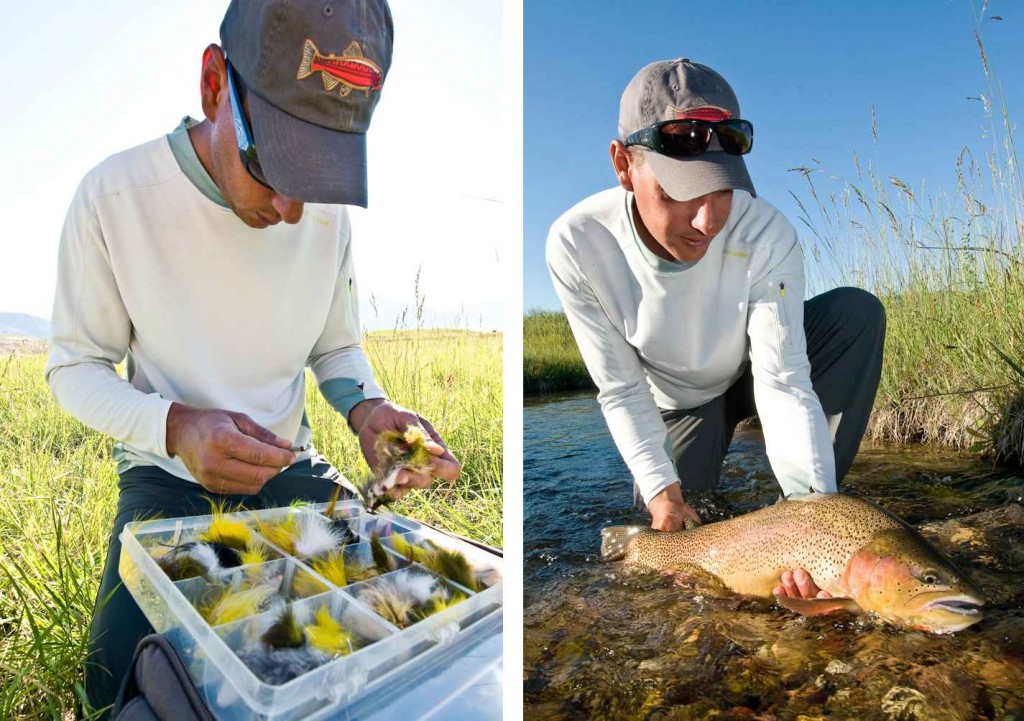
Fly Fishing Guide, Rob Parkins demonstrates how effective streamers can be on small streams. Photo By: Louis Cahill
Fly fishing to picky educated trout that get pounded daily by fly anglers, can get many of us flustered at times. It’s easy to find ourselves following everyone else’s lead on the water when it comes to pattern choice. Blue ribbon trout streams in Colorado come to mind, where the key to success is often sight-fishing with tiny nymphs on fine tippet. But even fishing the right fly patterns, you still are going to have to deal with hard to read intricate currents above and below the surface, of which, will constantly be trying to compromise your drift and fly placement. This is often the key factor in whether you fool or tip off the fish that your offering is not the real deal.
I’ll never forget a day on the upper Roaring Fork a couple years back that left me humbled to the core. I had no problem locating numerous trophy class fish. Hell, they were everywhere it seemed like, and often only a couple rod lengths away from me. Unfortunately, the majority of them were holding in all the wrong places, where it was almost impossible to get a good presentation and drift with my flies. I’d make what I thought was a perfect cast, and right when my flies were about to enter the target zone of the fish, I would lose my drift and the fish would slide off to the slide and give me the finger. An 11′ switch rod with a extra long leader was what I needed that day, but unfortunately, I left that rod at home. Those big beautiful fish on the Roaring Fork, gave me a whole new appreciation for PHD educated trout. They all seemed to know exactly where to sit and feed, just out of fly anglers reach. I finished that day with a few respectable mature trout and numerous other smaller fish that looked like they had been booted out of the prime lies. Knowing what I know now, I should have ditched the nymph rig and dead drifting, for a 2x-3x leader and a streamer. My numbers would have gone down, and I would have spooked some fish, but I bet I would have walked away from the river landing one of those truly massive trout.
It’s important to note that streamers aren’t just for big water, they can be equally effective on small to mid-size trout water as well. Having the guts to go against the norm and use different tactics from what everyone else is doing, can sometimes give you an edge. Instead of targeting trout that are drift feeding on tiny aquatic bugs and trying to match the hatch, you might consider opting for fishing a streamer in the hopes of triggering reaction strikes from a few big fish. After all, you’ve got nothing to lose if you’ve been striking out anyway, right? And who cares if you hook up because you triggered a territorial or impulse bite, because it’s hardwired in the DNA of all gamefish, trout included, and that makes it fair game in my eyes. These primordial instincts can often override trout intelligence, even the wisest of trout. Another plus with fishing a streamer is you won’t have to worry about dissecting and managing those challenging currents, you just cast and strip. Working a streamer through prime holding water or across the noses of spotted trout will eventually bring you success, and if you’re lucky, you may hook into and land the biggest trout of your life.
Keep it Reel,
Kent Klewein Gink & Gasoline www.ginkandgasoline.com hookups@ginkandgasoline.com Sign Up For Our Weekly Newsletter!
When fishing gets tough here in central Pa. and water is low and warm find deep pools and fish with streamers, you can often times entice a nice brute with a streamer.
Trap,
Thanks for the great tip. Trout tend to search out deeper water where water temps are cooler during the warmer seasons. I’ve seen places where springs seeping in from the bottom gathered upwards of 2 dozen fish.
Kent
Good stuff…I learned to be a streamer fisherman first, then dries, then nymphs.
I’m a practical sort, and it was obvious to me that learning to throw more forging streamers was the path to more early success, learning to cast effectively and the things that would make me a better fly fisherman.
The fact that it’s sometimes the go-to solution became evident pretty quickly.
Further North,
I to followed a similiar angling path. As we learn new techniques we sometimes forget where we dtarted and let others influence us. Sometimes its for the better but other times it hinders us.
Kent